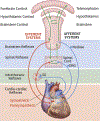Autonomic Nervous System Dysfunction: JACC Focus Seminar
- PMID: 30871703
- PMCID: PMC6958998
- DOI: 10.1016/j.jacc.2018.12.064
Autonomic Nervous System Dysfunction: JACC Focus Seminar
Abstract
Autonomic nervous system control of the heart is a dynamic process in both health and disease. A multilevel neural network is responsible for control of chronotropy, lusitropy, dromotropy, and inotropy. Intrinsic autonomic dysfunction arises from diseases that directly affect the autonomic nerves, such as diabetes mellitus and the syndromes of primary autonomic failure. Extrinsic autonomic dysfunction reflects the changes in autonomic function that are secondarily induced by cardiac or other disease. An array of tests interrogate various aspects of cardiac autonomic control in either resting conditions or with physiological perturbations from resting conditions. The prognostic significance of these assessments have been well established. Clinical usefulness has not been established, and the precise mechanistic link to mortality is less well established. Further efforts are required to develop optimal approaches to delineate cardiac autonomic dysfunction and its adverse effects to develop tools that can be used to guide clinical decision-making.
Keywords: arrhythmia; autonomic; heart failure; myocardial infarction.
Copyright © 2019 American College of Cardiology Foundation. Published by Elsevier Inc. All rights reserved.
Figures




